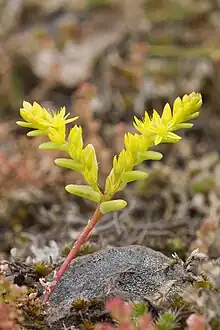Sedella (plant)
Sedella (formerly Parvisedum) is a small genus of annual flowering plants in the family Crassulaceae. There are approximately 7 species,[1] all native to California, United States, one with a distribution extending into Oregon. These are petite succulent plants growing a few centimeters tall and bearing tiny yellowish or brownish flowers. Mock stonecrop is a common name for these plants.[2]
| Sedella | |
|---|---|
 | |
| Sedella pumila | |
| Scientific classification | |
| Kingdom: | Plantae |
| Clade: | Tracheophytes |
| Clade: | Angiosperms |
| Clade: | Eudicots |
| Order: | Saxifragales |
| Family: | Crassulaceae |
| Subfamily: | Sempervivoideae |
| Tribe: | Sedeae |
| Genus: | Sedella Britton & Rose |
| Type species | |
| Sedella pumila | |
| Species | |
|
See text | |
Description
These plants are diminutive annuals, they grow erect and are glabrous (without hairs). The leaves are early-deciduous, sessile, and shaped oblong-elliptic to ovoid. The tips of the leaves are rounded to obtuse. The inflorescence has 1 to 2 flowers in 0 to 3 branched cyme, sub-sessile. There are 5 sepals and 5 petals. The petals are pale to bright or green-yellow, with a midrib that is often more or less red.[3]
Taxonomy
The genus was described by Nathaniel Lord Britton and Joseph Nelson Rose during their reorganization of the North American Crassulaceae.[4]
The name is the Latin diminutive of Sedum. The name Parvisedum is a synonym.[3]
Species
- Sedella atrata Fourr.
- Sedella carinthiaca (Hoppe ex Pacher) Á.Löve & D.Löve
- Sedella congdonii (Eastw.) Britton & Rose - Congdon's mock stonecrop
- Sedella leiocarpa H. Sharsm. - Lake County stonecrop
- Sedella pentandra H. Sharsm. - Mt. Hamilton mock stonecrop
- Sedella pumila (Benth.) Britton & Rose - Sierra mock stonecrop
- Sedella villosa (L.) Fourr.
References
- "Name Search=Sedella". Tropicos. Missouri Botanical Gardens. Retrieved 27 October 2017.
- USDA, NRCS (n.d.). "Sedella". The PLANTS Database (plants.usda.gov). Greensboro, North Carolina: National Plant Data Team. Retrieved 9 November 2015.
- Jepson Flora Project (ed.). "Sedella". Jepson eFlora. The Jepson Herbarium, University of California, Berkeley.
- Britton, Nathaniel L.; Rose, Joseph N. (1903). "New and noteworthy North American Crassulaceae". Bulletin of the New York Botanical Garden. 3 (9): 45.
- "Search term=Sedella". The Plant List. The Plant List. Retrieved 27 October 2017.